LSC UoS BA Business Studies: AI, Strategy, and Workforce Essay
VerifiedAdded on 2023/06/10
|9
|2667
|359
Essay
AI Summary
This essay critically evaluates the role and influence of artificial intelligence (AI) on business strategy and workforce management in a global environment. It highlights the significance of talent acquisition, learning and development, and change management, utilizing HR theories and competitive strategy models. The essay discusses how the COVID-19 pandemic has accelerated the adoption of digital technologies, with AI playing a crucial role in decision-making, process automation, and reshaping business strategies. It also addresses AI's impact on the workforce, emphasizing the need for effective change management and employee motivation. The essay concludes that businesses must adapt their strategies to effectively manage the workforce and operations in the face of technological advancements and global challenges, referencing PWC's AI integration as a case study.
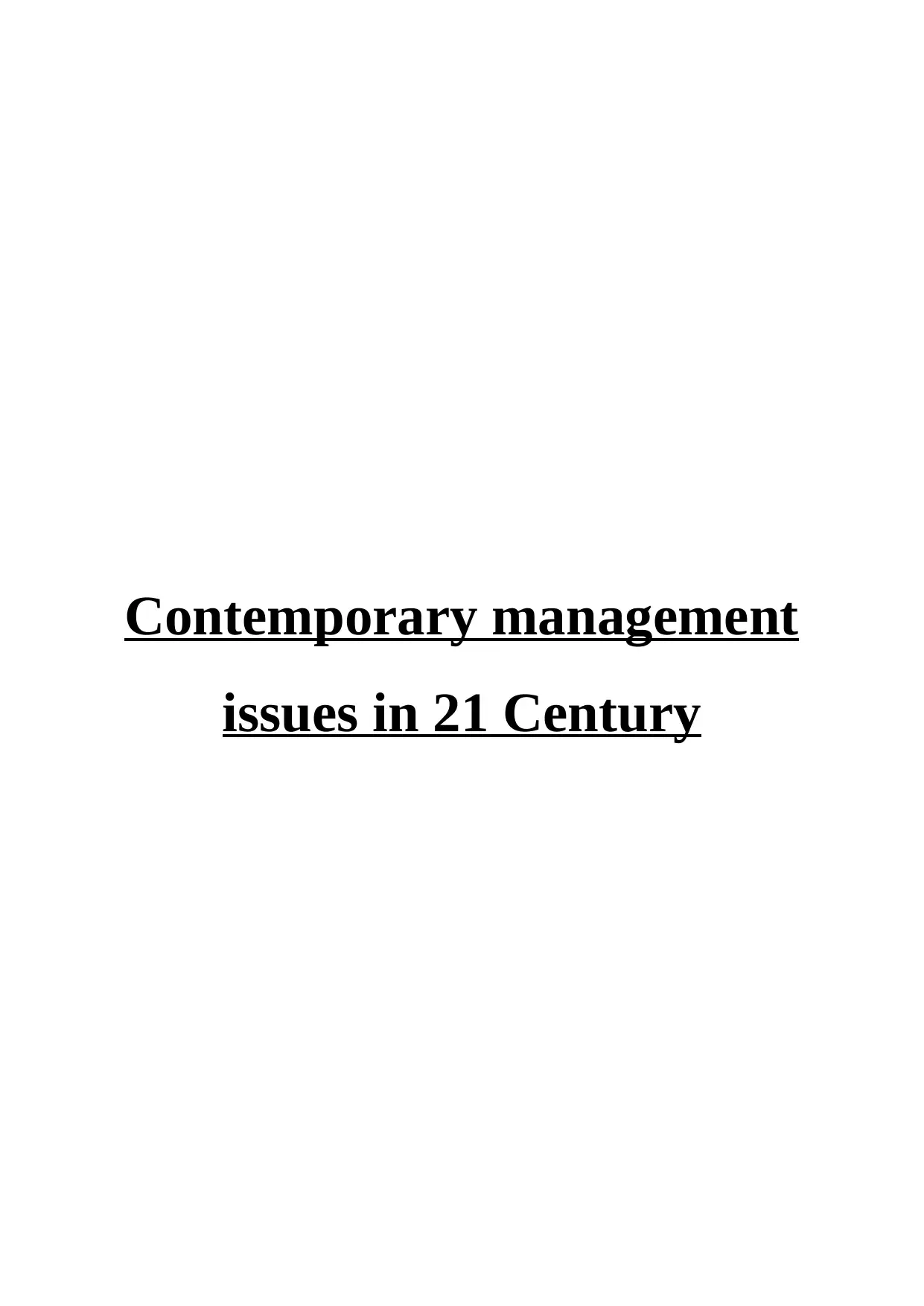
Contemporary management
issues in 21 Century
issues in 21 Century
Paraphrase This Document
Need a fresh take? Get an instant paraphrase of this document with our AI Paraphraser

CONTENTS
INTRODUCTION......................................................................................................................1
MAIN BODY.............................................................................................................................1
CONCLUSION..........................................................................................................................4
REFERENCES...........................................................................................................................5
INTRODUCTION......................................................................................................................1
MAIN BODY.............................................................................................................................1
CONCLUSION..........................................................................................................................4
REFERENCES...........................................................................................................................5
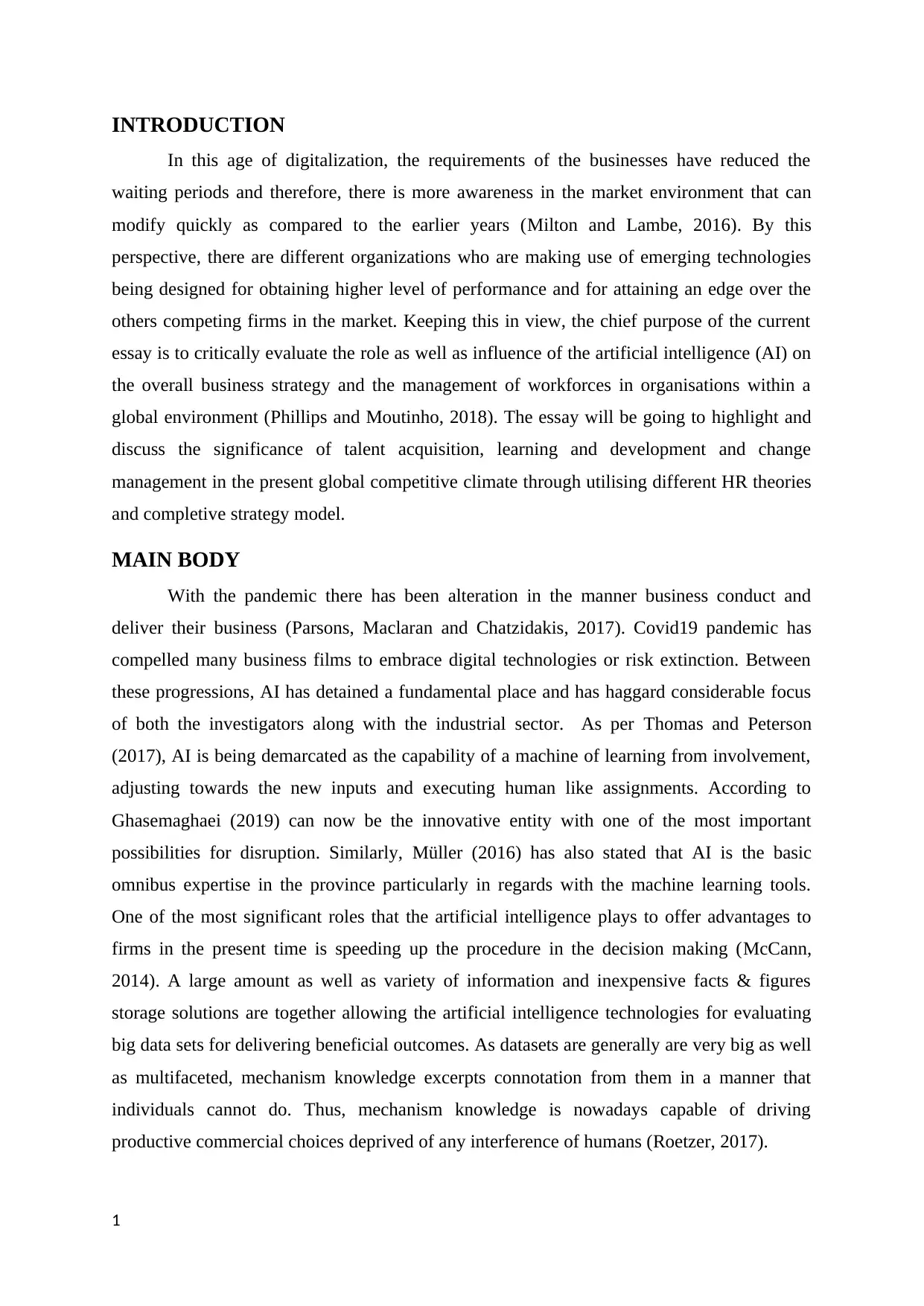
INTRODUCTION
In this age of digitalization, the requirements of the businesses have reduced the
waiting periods and therefore, there is more awareness in the market environment that can
modify quickly as compared to the earlier years (Milton and Lambe, 2016). By this
perspective, there are different organizations who are making use of emerging technologies
being designed for obtaining higher level of performance and for attaining an edge over the
others competing firms in the market. Keeping this in view, the chief purpose of the current
essay is to critically evaluate the role as well as influence of the artificial intelligence (AI) on
the overall business strategy and the management of workforces in organisations within a
global environment (Phillips and Moutinho, 2018). The essay will be going to highlight and
discuss the significance of talent acquisition, learning and development and change
management in the present global competitive climate through utilising different HR theories
and completive strategy model.
MAIN BODY
With the pandemic there has been alteration in the manner business conduct and
deliver their business (Parsons, Maclaran and Chatzidakis, 2017). Covid19 pandemic has
compelled many business films to embrace digital technologies or risk extinction. Between
these progressions, AI has detained a fundamental place and has haggard considerable focus
of both the investigators along with the industrial sector. As per Thomas and Peterson
(2017), AI is being demarcated as the capability of a machine of learning from involvement,
adjusting towards the new inputs and executing human like assignments. According to
Ghasemaghaei (2019) can now be the innovative entity with one of the most important
possibilities for disruption. Similarly, Müller (2016) has also stated that AI is the basic
omnibus expertise in the province particularly in regards with the machine learning tools.
One of the most significant roles that the artificial intelligence plays to offer advantages to
firms in the present time is speeding up the procedure in the decision making (McCann,
2014). A large amount as well as variety of information and inexpensive facts & figures
storage solutions are together allowing the artificial intelligence technologies for evaluating
big data sets for delivering beneficial outcomes. As datasets are generally are very big as well
as multifaceted, mechanism knowledge excerpts connotation from them in a manner that
individuals cannot do. Thus, mechanism knowledge is nowadays capable of driving
productive commercial choices deprived of any interference of humans (Roetzer, 2017).
1
In this age of digitalization, the requirements of the businesses have reduced the
waiting periods and therefore, there is more awareness in the market environment that can
modify quickly as compared to the earlier years (Milton and Lambe, 2016). By this
perspective, there are different organizations who are making use of emerging technologies
being designed for obtaining higher level of performance and for attaining an edge over the
others competing firms in the market. Keeping this in view, the chief purpose of the current
essay is to critically evaluate the role as well as influence of the artificial intelligence (AI) on
the overall business strategy and the management of workforces in organisations within a
global environment (Phillips and Moutinho, 2018). The essay will be going to highlight and
discuss the significance of talent acquisition, learning and development and change
management in the present global competitive climate through utilising different HR theories
and completive strategy model.
MAIN BODY
With the pandemic there has been alteration in the manner business conduct and
deliver their business (Parsons, Maclaran and Chatzidakis, 2017). Covid19 pandemic has
compelled many business films to embrace digital technologies or risk extinction. Between
these progressions, AI has detained a fundamental place and has haggard considerable focus
of both the investigators along with the industrial sector. As per Thomas and Peterson
(2017), AI is being demarcated as the capability of a machine of learning from involvement,
adjusting towards the new inputs and executing human like assignments. According to
Ghasemaghaei (2019) can now be the innovative entity with one of the most important
possibilities for disruption. Similarly, Müller (2016) has also stated that AI is the basic
omnibus expertise in the province particularly in regards with the machine learning tools.
One of the most significant roles that the artificial intelligence plays to offer advantages to
firms in the present time is speeding up the procedure in the decision making (McCann,
2014). A large amount as well as variety of information and inexpensive facts & figures
storage solutions are together allowing the artificial intelligence technologies for evaluating
big data sets for delivering beneficial outcomes. As datasets are generally are very big as well
as multifaceted, mechanism knowledge excerpts connotation from them in a manner that
individuals cannot do. Thus, mechanism knowledge is nowadays capable of driving
productive commercial choices deprived of any interference of humans (Roetzer, 2017).
1
⊘ This is a preview!⊘
Do you want full access?
Subscribe today to unlock all pages.

Trusted by 1+ million students worldwide
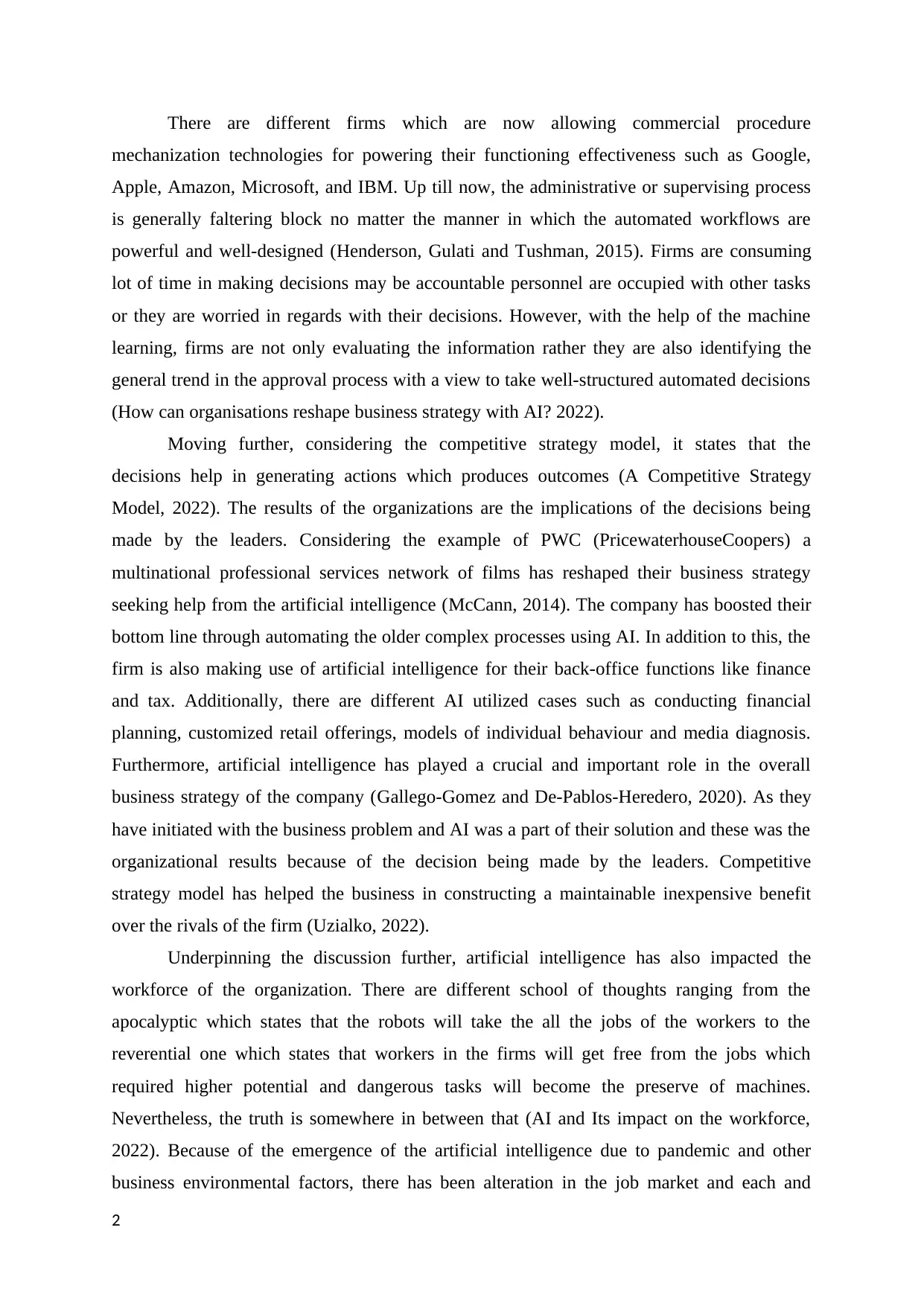
There are different firms which are now allowing commercial procedure
mechanization technologies for powering their functioning effectiveness such as Google,
Apple, Amazon, Microsoft, and IBM. Up till now, the administrative or supervising process
is generally faltering block no matter the manner in which the automated workflows are
powerful and well-designed (Henderson, Gulati and Tushman, 2015). Firms are consuming
lot of time in making decisions may be accountable personnel are occupied with other tasks
or they are worried in regards with their decisions. However, with the help of the machine
learning, firms are not only evaluating the information rather they are also identifying the
general trend in the approval process with a view to take well-structured automated decisions
(How can organisations reshape business strategy with AI? 2022).
Moving further, considering the competitive strategy model, it states that the
decisions help in generating actions which produces outcomes (A Competitive Strategy
Model, 2022). The results of the organizations are the implications of the decisions being
made by the leaders. Considering the example of PWC (PricewaterhouseCoopers) a
multinational professional services network of films has reshaped their business strategy
seeking help from the artificial intelligence (McCann, 2014). The company has boosted their
bottom line through automating the older complex processes using AI. In addition to this, the
firm is also making use of artificial intelligence for their back-office functions like finance
and tax. Additionally, there are different AI utilized cases such as conducting financial
planning, customized retail offerings, models of individual behaviour and media diagnosis.
Furthermore, artificial intelligence has played a crucial and important role in the overall
business strategy of the company (Gallego-Gomez and De-Pablos-Heredero, 2020). As they
have initiated with the business problem and AI was a part of their solution and these was the
organizational results because of the decision being made by the leaders. Competitive
strategy model has helped the business in constructing a maintainable inexpensive benefit
over the rivals of the firm (Uzialko, 2022).
Underpinning the discussion further, artificial intelligence has also impacted the
workforce of the organization. There are different school of thoughts ranging from the
apocalyptic which states that the robots will take the all the jobs of the workers to the
reverential one which states that workers in the firms will get free from the jobs which
required higher potential and dangerous tasks will become the preserve of machines.
Nevertheless, the truth is somewhere in between that (AI and Its impact on the workforce,
2022). Because of the emergence of the artificial intelligence due to pandemic and other
business environmental factors, there has been alteration in the job market and each and
2
mechanization technologies for powering their functioning effectiveness such as Google,
Apple, Amazon, Microsoft, and IBM. Up till now, the administrative or supervising process
is generally faltering block no matter the manner in which the automated workflows are
powerful and well-designed (Henderson, Gulati and Tushman, 2015). Firms are consuming
lot of time in making decisions may be accountable personnel are occupied with other tasks
or they are worried in regards with their decisions. However, with the help of the machine
learning, firms are not only evaluating the information rather they are also identifying the
general trend in the approval process with a view to take well-structured automated decisions
(How can organisations reshape business strategy with AI? 2022).
Moving further, considering the competitive strategy model, it states that the
decisions help in generating actions which produces outcomes (A Competitive Strategy
Model, 2022). The results of the organizations are the implications of the decisions being
made by the leaders. Considering the example of PWC (PricewaterhouseCoopers) a
multinational professional services network of films has reshaped their business strategy
seeking help from the artificial intelligence (McCann, 2014). The company has boosted their
bottom line through automating the older complex processes using AI. In addition to this, the
firm is also making use of artificial intelligence for their back-office functions like finance
and tax. Additionally, there are different AI utilized cases such as conducting financial
planning, customized retail offerings, models of individual behaviour and media diagnosis.
Furthermore, artificial intelligence has played a crucial and important role in the overall
business strategy of the company (Gallego-Gomez and De-Pablos-Heredero, 2020). As they
have initiated with the business problem and AI was a part of their solution and these was the
organizational results because of the decision being made by the leaders. Competitive
strategy model has helped the business in constructing a maintainable inexpensive benefit
over the rivals of the firm (Uzialko, 2022).
Underpinning the discussion further, artificial intelligence has also impacted the
workforce of the organization. There are different school of thoughts ranging from the
apocalyptic which states that the robots will take the all the jobs of the workers to the
reverential one which states that workers in the firms will get free from the jobs which
required higher potential and dangerous tasks will become the preserve of machines.
Nevertheless, the truth is somewhere in between that (AI and Its impact on the workforce,
2022). Because of the emergence of the artificial intelligence due to pandemic and other
business environmental factors, there has been alteration in the job market and each and
2
Paraphrase This Document
Need a fresh take? Get an instant paraphrase of this document with our AI Paraphraser
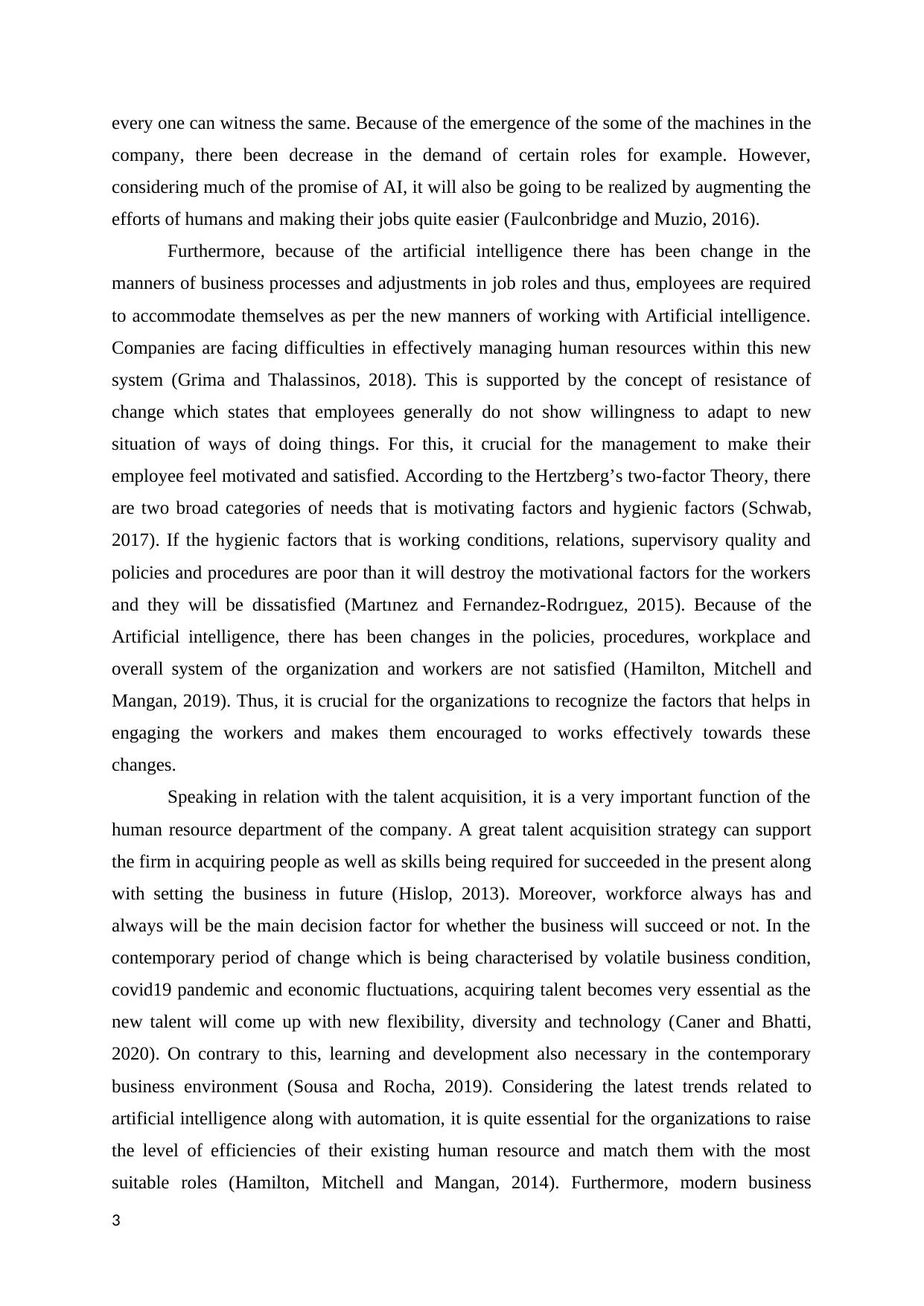
every one can witness the same. Because of the emergence of the some of the machines in the
company, there been decrease in the demand of certain roles for example. However,
considering much of the promise of AI, it will also be going to be realized by augmenting the
efforts of humans and making their jobs quite easier (Faulconbridge and Muzio, 2016).
Furthermore, because of the artificial intelligence there has been change in the
manners of business processes and adjustments in job roles and thus, employees are required
to accommodate themselves as per the new manners of working with Artificial intelligence.
Companies are facing difficulties in effectively managing human resources within this new
system (Grima and Thalassinos, 2018). This is supported by the concept of resistance of
change which states that employees generally do not show willingness to adapt to new
situation of ways of doing things. For this, it crucial for the management to make their
employee feel motivated and satisfied. According to the Hertzberg’s two-factor Theory, there
are two broad categories of needs that is motivating factors and hygienic factors (Schwab,
2017). If the hygienic factors that is working conditions, relations, supervisory quality and
policies and procedures are poor than it will destroy the motivational factors for the workers
and they will be dissatisfied (Martınez and Fernandez-Rodrıguez, 2015). Because of the
Artificial intelligence, there has been changes in the policies, procedures, workplace and
overall system of the organization and workers are not satisfied (Hamilton, Mitchell and
Mangan, 2019). Thus, it is crucial for the organizations to recognize the factors that helps in
engaging the workers and makes them encouraged to works effectively towards these
changes.
Speaking in relation with the talent acquisition, it is a very important function of the
human resource department of the company. A great talent acquisition strategy can support
the firm in acquiring people as well as skills being required for succeeded in the present along
with setting the business in future (Hislop, 2013). Moreover, workforce always has and
always will be the main decision factor for whether the business will succeed or not. In the
contemporary period of change which is being characterised by volatile business condition,
covid19 pandemic and economic fluctuations, acquiring talent becomes very essential as the
new talent will come up with new flexibility, diversity and technology (Caner and Bhatti,
2020). On contrary to this, learning and development also necessary in the contemporary
business environment (Sousa and Rocha, 2019). Considering the latest trends related to
artificial intelligence along with automation, it is quite essential for the organizations to raise
the level of efficiencies of their existing human resource and match them with the most
suitable roles (Hamilton, Mitchell and Mangan, 2014). Furthermore, modern business
3
company, there been decrease in the demand of certain roles for example. However,
considering much of the promise of AI, it will also be going to be realized by augmenting the
efforts of humans and making their jobs quite easier (Faulconbridge and Muzio, 2016).
Furthermore, because of the artificial intelligence there has been change in the
manners of business processes and adjustments in job roles and thus, employees are required
to accommodate themselves as per the new manners of working with Artificial intelligence.
Companies are facing difficulties in effectively managing human resources within this new
system (Grima and Thalassinos, 2018). This is supported by the concept of resistance of
change which states that employees generally do not show willingness to adapt to new
situation of ways of doing things. For this, it crucial for the management to make their
employee feel motivated and satisfied. According to the Hertzberg’s two-factor Theory, there
are two broad categories of needs that is motivating factors and hygienic factors (Schwab,
2017). If the hygienic factors that is working conditions, relations, supervisory quality and
policies and procedures are poor than it will destroy the motivational factors for the workers
and they will be dissatisfied (Martınez and Fernandez-Rodrıguez, 2015). Because of the
Artificial intelligence, there has been changes in the policies, procedures, workplace and
overall system of the organization and workers are not satisfied (Hamilton, Mitchell and
Mangan, 2019). Thus, it is crucial for the organizations to recognize the factors that helps in
engaging the workers and makes them encouraged to works effectively towards these
changes.
Speaking in relation with the talent acquisition, it is a very important function of the
human resource department of the company. A great talent acquisition strategy can support
the firm in acquiring people as well as skills being required for succeeded in the present along
with setting the business in future (Hislop, 2013). Moreover, workforce always has and
always will be the main decision factor for whether the business will succeed or not. In the
contemporary period of change which is being characterised by volatile business condition,
covid19 pandemic and economic fluctuations, acquiring talent becomes very essential as the
new talent will come up with new flexibility, diversity and technology (Caner and Bhatti,
2020). On contrary to this, learning and development also necessary in the contemporary
business environment (Sousa and Rocha, 2019). Considering the latest trends related to
artificial intelligence along with automation, it is quite essential for the organizations to raise
the level of efficiencies of their existing human resource and match them with the most
suitable roles (Hamilton, Mitchell and Mangan, 2014). Furthermore, modern business
3
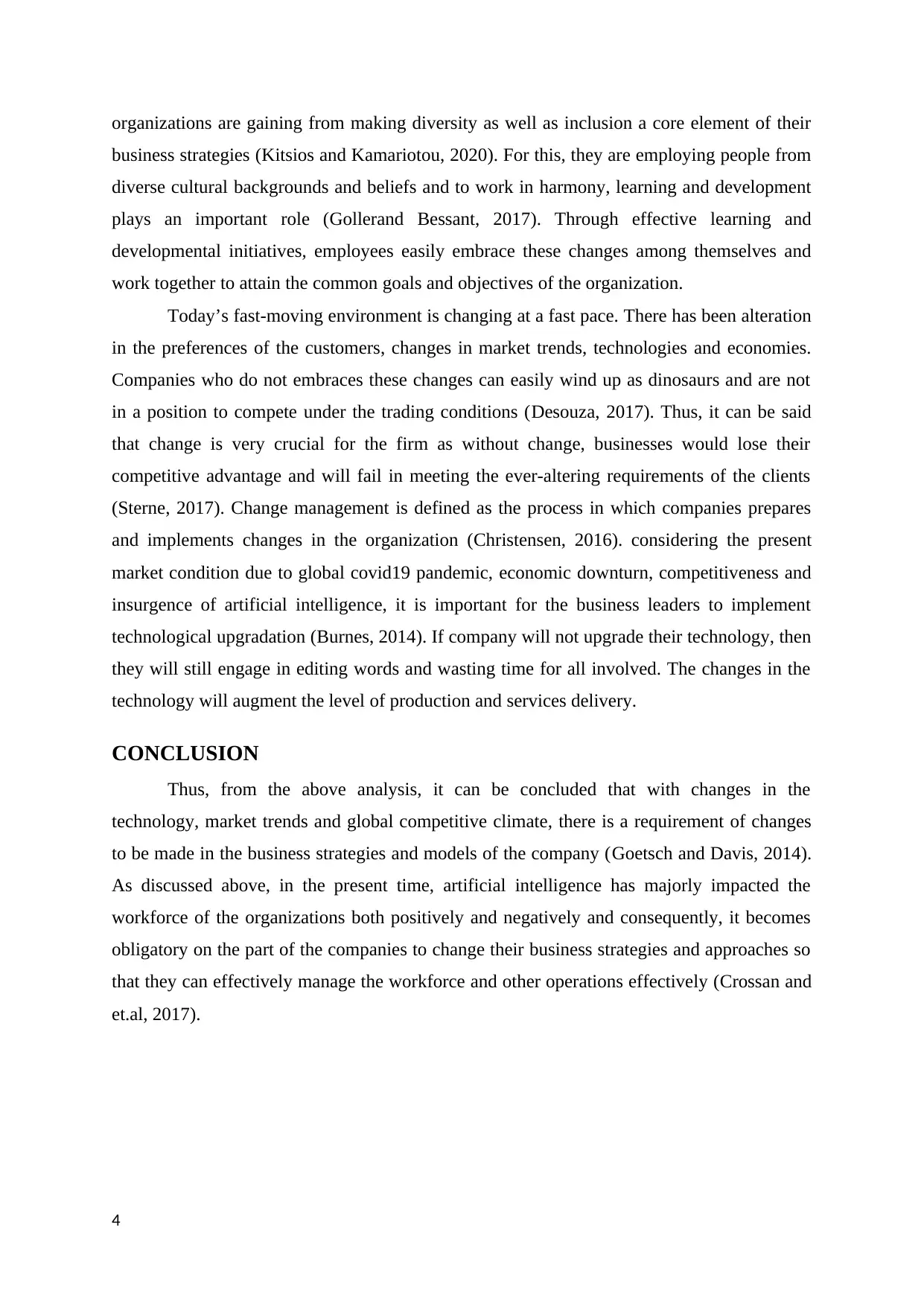
organizations are gaining from making diversity as well as inclusion a core element of their
business strategies (Kitsios and Kamariotou, 2020). For this, they are employing people from
diverse cultural backgrounds and beliefs and to work in harmony, learning and development
plays an important role (Gollerand Bessant, 2017). Through effective learning and
developmental initiatives, employees easily embrace these changes among themselves and
work together to attain the common goals and objectives of the organization.
Today’s fast-moving environment is changing at a fast pace. There has been alteration
in the preferences of the customers, changes in market trends, technologies and economies.
Companies who do not embraces these changes can easily wind up as dinosaurs and are not
in a position to compete under the trading conditions (Desouza, 2017). Thus, it can be said
that change is very crucial for the firm as without change, businesses would lose their
competitive advantage and will fail in meeting the ever-altering requirements of the clients
(Sterne, 2017). Change management is defined as the process in which companies prepares
and implements changes in the organization (Christensen, 2016). considering the present
market condition due to global covid19 pandemic, economic downturn, competitiveness and
insurgence of artificial intelligence, it is important for the business leaders to implement
technological upgradation (Burnes, 2014). If company will not upgrade their technology, then
they will still engage in editing words and wasting time for all involved. The changes in the
technology will augment the level of production and services delivery.
CONCLUSION
Thus, from the above analysis, it can be concluded that with changes in the
technology, market trends and global competitive climate, there is a requirement of changes
to be made in the business strategies and models of the company (Goetsch and Davis, 2014).
As discussed above, in the present time, artificial intelligence has majorly impacted the
workforce of the organizations both positively and negatively and consequently, it becomes
obligatory on the part of the companies to change their business strategies and approaches so
that they can effectively manage the workforce and other operations effectively (Crossan and
et.al, 2017).
4
business strategies (Kitsios and Kamariotou, 2020). For this, they are employing people from
diverse cultural backgrounds and beliefs and to work in harmony, learning and development
plays an important role (Gollerand Bessant, 2017). Through effective learning and
developmental initiatives, employees easily embrace these changes among themselves and
work together to attain the common goals and objectives of the organization.
Today’s fast-moving environment is changing at a fast pace. There has been alteration
in the preferences of the customers, changes in market trends, technologies and economies.
Companies who do not embraces these changes can easily wind up as dinosaurs and are not
in a position to compete under the trading conditions (Desouza, 2017). Thus, it can be said
that change is very crucial for the firm as without change, businesses would lose their
competitive advantage and will fail in meeting the ever-altering requirements of the clients
(Sterne, 2017). Change management is defined as the process in which companies prepares
and implements changes in the organization (Christensen, 2016). considering the present
market condition due to global covid19 pandemic, economic downturn, competitiveness and
insurgence of artificial intelligence, it is important for the business leaders to implement
technological upgradation (Burnes, 2014). If company will not upgrade their technology, then
they will still engage in editing words and wasting time for all involved. The changes in the
technology will augment the level of production and services delivery.
CONCLUSION
Thus, from the above analysis, it can be concluded that with changes in the
technology, market trends and global competitive climate, there is a requirement of changes
to be made in the business strategies and models of the company (Goetsch and Davis, 2014).
As discussed above, in the present time, artificial intelligence has majorly impacted the
workforce of the organizations both positively and negatively and consequently, it becomes
obligatory on the part of the companies to change their business strategies and approaches so
that they can effectively manage the workforce and other operations effectively (Crossan and
et.al, 2017).
4
⊘ This is a preview!⊘
Do you want full access?
Subscribe today to unlock all pages.

Trusted by 1+ million students worldwide
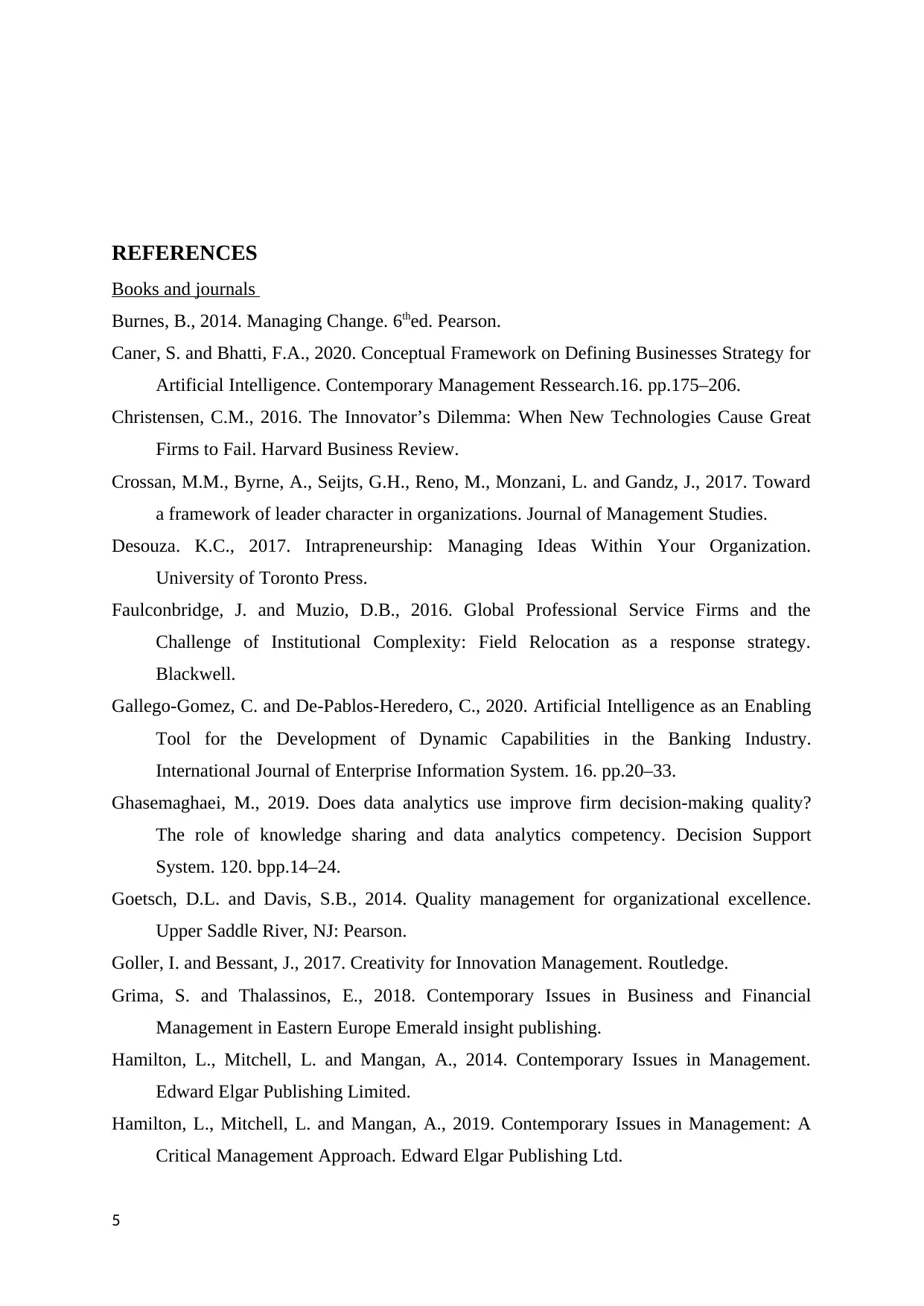
REFERENCES
Books and journals
Burnes, B., 2014. Managing Change. 6thed. Pearson.
Caner, S. and Bhatti, F.A., 2020. Conceptual Framework on Defining Businesses Strategy for
Artificial Intelligence. Contemporary Management Ressearch.16. pp.175–206.
Christensen, C.M., 2016. The Innovator’s Dilemma: When New Technologies Cause Great
Firms to Fail. Harvard Business Review.
Crossan, M.M., Byrne, A., Seijts, G.H., Reno, M., Monzani, L. and Gandz, J., 2017. Toward
a framework of leader character in organizations. Journal of Management Studies.
Desouza. K.C., 2017. Intrapreneurship: Managing Ideas Within Your Organization.
University of Toronto Press.
Faulconbridge, J. and Muzio, D.B., 2016. Global Professional Service Firms and the
Challenge of Institutional Complexity: Field Relocation as a response strategy.
Blackwell.
Gallego-Gomez, C. and De-Pablos-Heredero, C., 2020. Artificial Intelligence as an Enabling
Tool for the Development of Dynamic Capabilities in the Banking Industry.
International Journal of Enterprise Information System. 16. pp.20–33.
Ghasemaghaei, M., 2019. Does data analytics use improve firm decision-making quality?
The role of knowledge sharing and data analytics competency. Decision Support
System. 120. bpp.14–24.
Goetsch, D.L. and Davis, S.B., 2014. Quality management for organizational excellence.
Upper Saddle River, NJ: Pearson.
Goller, I. and Bessant, J., 2017. Creativity for Innovation Management. Routledge.
Grima, S. and Thalassinos, E., 2018. Contemporary Issues in Business and Financial
Management in Eastern Europe Emerald insight publishing.
Hamilton, L., Mitchell, L. and Mangan, A., 2014. Contemporary Issues in Management.
Edward Elgar Publishing Limited.
Hamilton, L., Mitchell, L. and Mangan, A., 2019. Contemporary Issues in Management: A
Critical Management Approach. Edward Elgar Publishing Ltd.
5
Books and journals
Burnes, B., 2014. Managing Change. 6thed. Pearson.
Caner, S. and Bhatti, F.A., 2020. Conceptual Framework on Defining Businesses Strategy for
Artificial Intelligence. Contemporary Management Ressearch.16. pp.175–206.
Christensen, C.M., 2016. The Innovator’s Dilemma: When New Technologies Cause Great
Firms to Fail. Harvard Business Review.
Crossan, M.M., Byrne, A., Seijts, G.H., Reno, M., Monzani, L. and Gandz, J., 2017. Toward
a framework of leader character in organizations. Journal of Management Studies.
Desouza. K.C., 2017. Intrapreneurship: Managing Ideas Within Your Organization.
University of Toronto Press.
Faulconbridge, J. and Muzio, D.B., 2016. Global Professional Service Firms and the
Challenge of Institutional Complexity: Field Relocation as a response strategy.
Blackwell.
Gallego-Gomez, C. and De-Pablos-Heredero, C., 2020. Artificial Intelligence as an Enabling
Tool for the Development of Dynamic Capabilities in the Banking Industry.
International Journal of Enterprise Information System. 16. pp.20–33.
Ghasemaghaei, M., 2019. Does data analytics use improve firm decision-making quality?
The role of knowledge sharing and data analytics competency. Decision Support
System. 120. bpp.14–24.
Goetsch, D.L. and Davis, S.B., 2014. Quality management for organizational excellence.
Upper Saddle River, NJ: Pearson.
Goller, I. and Bessant, J., 2017. Creativity for Innovation Management. Routledge.
Grima, S. and Thalassinos, E., 2018. Contemporary Issues in Business and Financial
Management in Eastern Europe Emerald insight publishing.
Hamilton, L., Mitchell, L. and Mangan, A., 2014. Contemporary Issues in Management.
Edward Elgar Publishing Limited.
Hamilton, L., Mitchell, L. and Mangan, A., 2019. Contemporary Issues in Management: A
Critical Management Approach. Edward Elgar Publishing Ltd.
5
Paraphrase This Document
Need a fresh take? Get an instant paraphrase of this document with our AI Paraphraser
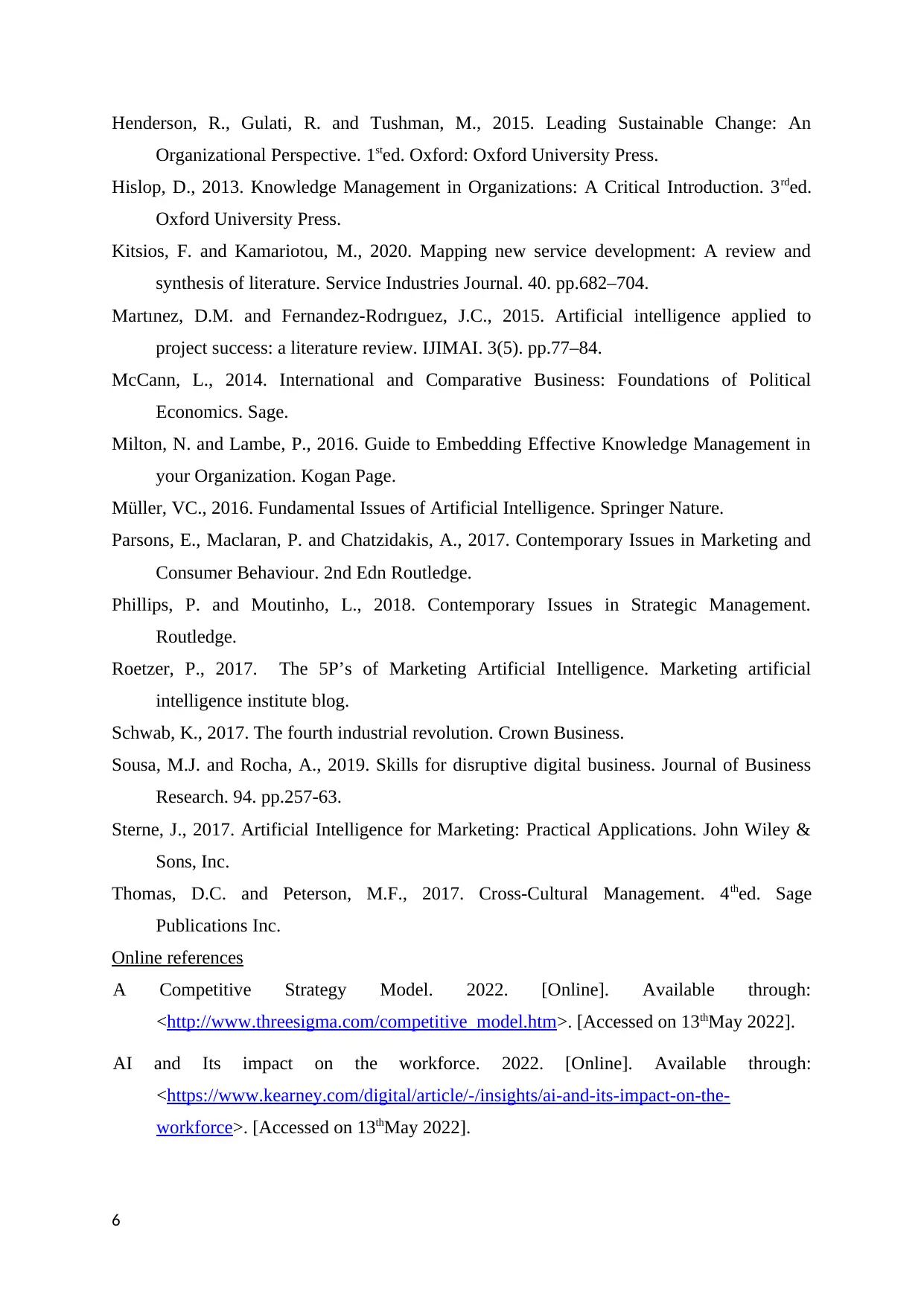
Henderson, R., Gulati, R. and Tushman, M., 2015. Leading Sustainable Change: An
Organizational Perspective. 1sted. Oxford: Oxford University Press.
Hislop, D., 2013. Knowledge Management in Organizations: A Critical Introduction. 3rded.
Oxford University Press.
Kitsios, F. and Kamariotou, M., 2020. Mapping new service development: A review and
synthesis of literature. Service Industries Journal. 40. pp.682–704.
Martınez, D.M. and Fernandez-Rodrıguez, J.C., 2015. Artificial intelligence applied to
project success: a literature review. IJIMAI. 3(5). pp.77–84.
McCann, L., 2014. International and Comparative Business: Foundations of Political
Economics. Sage.
Milton, N. and Lambe, P., 2016. Guide to Embedding Effective Knowledge Management in
your Organization. Kogan Page.
Müller, VC., 2016. Fundamental Issues of Artificial Intelligence. Springer Nature.
Parsons, E., Maclaran, P. and Chatzidakis, A., 2017. Contemporary Issues in Marketing and
Consumer Behaviour. 2nd Edn Routledge.
Phillips, P. and Moutinho, L., 2018. Contemporary Issues in Strategic Management.
Routledge.
Roetzer, P., 2017. The 5P’s of Marketing Artificial Intelligence. Marketing artificial
intelligence institute blog.
Schwab, K., 2017. The fourth industrial revolution. Crown Business.
Sousa, M.J. and Rocha, A., 2019. Skills for disruptive digital business. Journal of Business
Research. 94. pp.257-63.
Sterne, J., 2017. Artificial Intelligence for Marketing: Practical Applications. John Wiley &
Sons, Inc.
Thomas, D.C. and Peterson, M.F., 2017. Cross-Cultural Management. 4thed. Sage
Publications Inc.
Online references
A Competitive Strategy Model. 2022. [Online]. Available through:
<http://www.threesigma.com/competitive_model.htm>. [Accessed on 13thMay 2022].
AI and Its impact on the workforce. 2022. [Online]. Available through:
<https://www.kearney.com/digital/article/-/insights/ai-and-its-impact-on-the-
workforce>. [Accessed on 13thMay 2022].
6
Organizational Perspective. 1sted. Oxford: Oxford University Press.
Hislop, D., 2013. Knowledge Management in Organizations: A Critical Introduction. 3rded.
Oxford University Press.
Kitsios, F. and Kamariotou, M., 2020. Mapping new service development: A review and
synthesis of literature. Service Industries Journal. 40. pp.682–704.
Martınez, D.M. and Fernandez-Rodrıguez, J.C., 2015. Artificial intelligence applied to
project success: a literature review. IJIMAI. 3(5). pp.77–84.
McCann, L., 2014. International and Comparative Business: Foundations of Political
Economics. Sage.
Milton, N. and Lambe, P., 2016. Guide to Embedding Effective Knowledge Management in
your Organization. Kogan Page.
Müller, VC., 2016. Fundamental Issues of Artificial Intelligence. Springer Nature.
Parsons, E., Maclaran, P. and Chatzidakis, A., 2017. Contemporary Issues in Marketing and
Consumer Behaviour. 2nd Edn Routledge.
Phillips, P. and Moutinho, L., 2018. Contemporary Issues in Strategic Management.
Routledge.
Roetzer, P., 2017. The 5P’s of Marketing Artificial Intelligence. Marketing artificial
intelligence institute blog.
Schwab, K., 2017. The fourth industrial revolution. Crown Business.
Sousa, M.J. and Rocha, A., 2019. Skills for disruptive digital business. Journal of Business
Research. 94. pp.257-63.
Sterne, J., 2017. Artificial Intelligence for Marketing: Practical Applications. John Wiley &
Sons, Inc.
Thomas, D.C. and Peterson, M.F., 2017. Cross-Cultural Management. 4thed. Sage
Publications Inc.
Online references
A Competitive Strategy Model. 2022. [Online]. Available through:
<http://www.threesigma.com/competitive_model.htm>. [Accessed on 13thMay 2022].
AI and Its impact on the workforce. 2022. [Online]. Available through:
<https://www.kearney.com/digital/article/-/insights/ai-and-its-impact-on-the-
workforce>. [Accessed on 13thMay 2022].
6
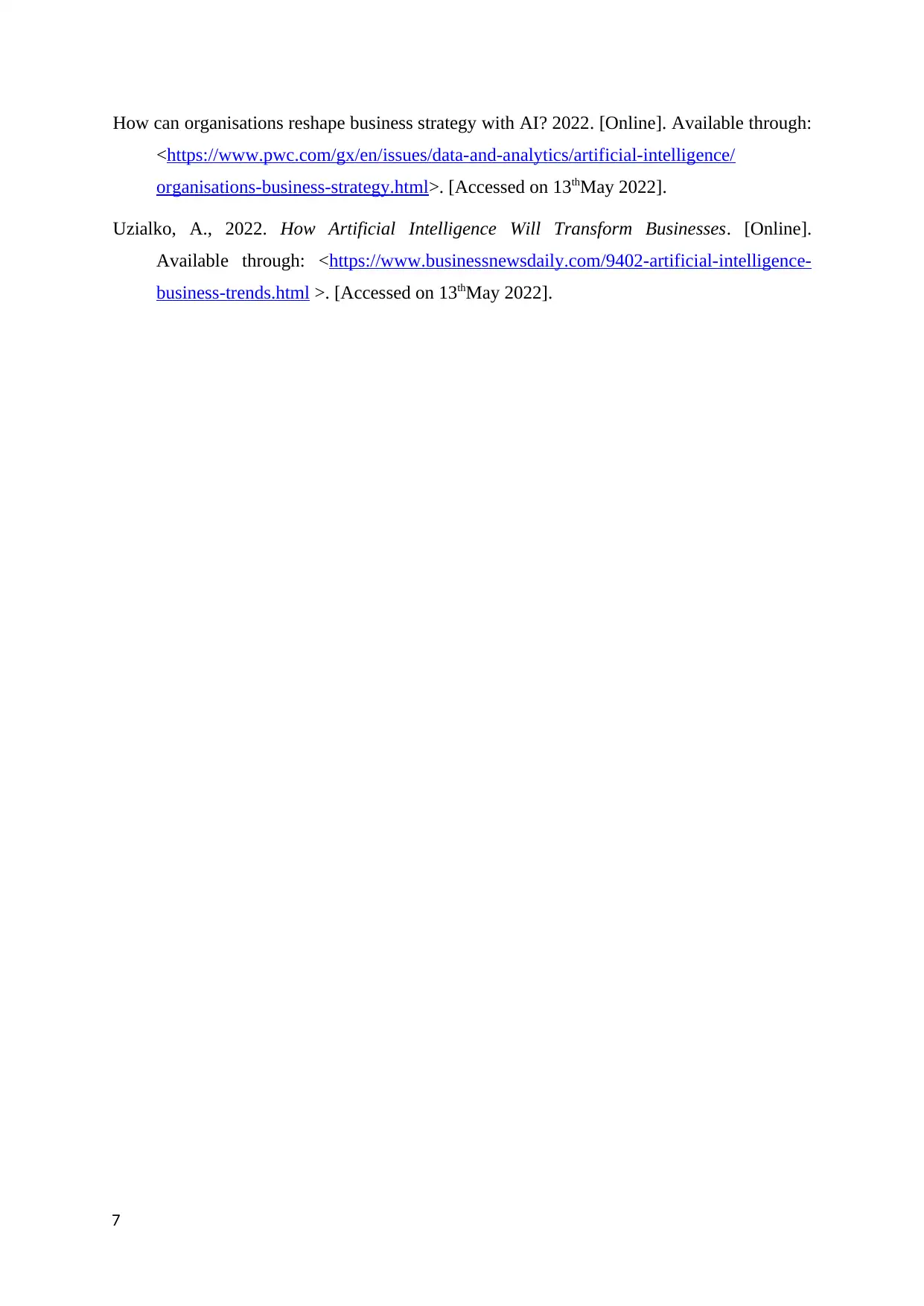
How can organisations reshape business strategy with AI? 2022. [Online]. Available through:
<https://www.pwc.com/gx/en/issues/data-and-analytics/artificial-intelligence/
organisations-business-strategy.html>. [Accessed on 13thMay 2022].
Uzialko, A., 2022. How Artificial Intelligence Will Transform Businesses. [Online].
Available through: <https://www.businessnewsdaily.com/9402-artificial-intelligence-
business-trends.html >. [Accessed on 13thMay 2022].
7
<https://www.pwc.com/gx/en/issues/data-and-analytics/artificial-intelligence/
organisations-business-strategy.html>. [Accessed on 13thMay 2022].
Uzialko, A., 2022. How Artificial Intelligence Will Transform Businesses. [Online].
Available through: <https://www.businessnewsdaily.com/9402-artificial-intelligence-
business-trends.html >. [Accessed on 13thMay 2022].
7
⊘ This is a preview!⊘
Do you want full access?
Subscribe today to unlock all pages.

Trusted by 1+ million students worldwide
1 out of 9
Related Documents
Your All-in-One AI-Powered Toolkit for Academic Success.
+13062052269
info@desklib.com
Available 24*7 on WhatsApp / Email
![[object Object]](/_next/static/media/star-bottom.7253800d.svg)
Unlock your academic potential
Copyright © 2020–2025 A2Z Services. All Rights Reserved. Developed and managed by ZUCOL.





